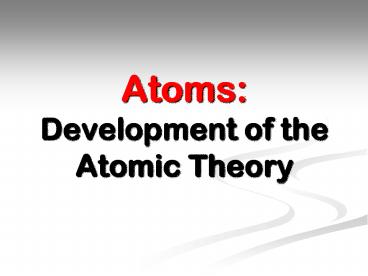Atoms: Development of the Atomic Theory - PowerPoint PPT Presentation
Title:
Atoms: Development of the Atomic Theory
Description:
Atoms: Development of the Atomic Theory Democritus 460 BC - Greek philosopher proposes the existence of the atom He pounded materials until he made them into smaller ... – PowerPoint PPT presentation
Number of Views:293
Avg rating:3.0/5.0
Title: Atoms: Development of the Atomic Theory
1
AtomsDevelopment of the Atomic Theory
2
Democritus
- 460 BC - Greek philosopher proposes the existence
of the atom - He pounded materials until he made them into
smaller and smaller parts - He called them atoma which is Greek for
indivisible.
3
Democritus
- His Theory
- All atoms
- Are small hard particles
- Are made of a single material formed into
different shapes and sizes - Are always moving, and they form different
materials by joining together
4
John Dalton
- 1803 - British chemist elements combine in
specific proportions to form compounds
Solid Sphere Model or Bowling Ball Model Proposed
by John Dalton
5
John Dalton
- His Theory
- All substances are made of atoms that cannot be
created, divided, or destroyed. - Atoms join with other atoms to make new
substances. - Atoms of the same element are exactly alike, and
atoms of different elements are different in mass
and size.
6
J.J. Thomson
- 1897 - English chemist and physicist discovered
1st subatomic particles
Plum Pudding Model or Raisin Bun Model Proposed
by J.J. Thomson
7
J.J. Thomson
- His Theory
- Atoms contain negatively charged particles called
electrons and positively charged matter. - Created a model to describe the atom as a sphere
filled with positive matter with negative
particles mixed in - Referred to it as the plum pudding model
8
Ernest Rutherford
- 1912 - New Zealand physicist discovered the
nucleus
Nuclear Model Proposed by Ernest Rutherford
9
Ernest Rutherford
- His Theory
- Small, dense, positively charged particle present
in nucleus called a proton - Electrons travel around the nucleus, but their
exact places cannot be described.
10
Niels Bohr
- 1913 - Danish physicist discovered energy levels
Bohr Model or Planetary Model Proposed by Niels
Bohr
11
Niels Bohr
- His Theory
- Electrons travel around the nucleus in definite
paths and fixed distances. - Electrons can jump from one level to a path in
another level.
12
Erwin Shrodinger
- 1924 - Austrian physicist developed the electron
cloud model
Electron Cloud Model Proposed by Erwin
Schrodinger
13
Erwin Shrodinger
- His Theory
- The exact path of electrons cannot be predicted.
- The region referred to as the electron cloud, is
an area where electrons can likely be found.
14
James Chadwick
- 1932 - English physicist discovered neutrons
- His Theory
- Neutrons have no electrical charge.
- Neutrons have a mass nearly equal to the mass of
a proton. - Unit of measurement for subatomic particles is
the atomic mass unit (amu).
15
Modern Theory of the Atom
- Atoms are composed of three main subatomic
particles the electron, proton, and neutron. - Most of the mass of the atom is concentrated in
the nucleus of the atom.
16
Modern Theory of the Atom
- The protons and neutrons are located within the
nucleus, while the electrons exist outside of the
nucleus. - In stable atoms, the number of protons is equal
to the number of electrons.
17
Modern Theory of the Atom
- The type of atom is determined by the number of
protons it has. - The number of protons in an atom is equal to the
atomic number.
18
Modern Theory of the Atom
- The sum of the number of protons and neutrons in
a particular atom is called the atomic mass. - Valence electrons are the outermost electrons.































